To risk becoming obsolete, companies around the world are pouring millions into digital transformation initiatives. Many, though, are putting the proverbial cart before the horse— investing in technologies rather than doing what’s needed first: changing their overall business strategy.
A smart digital strategy is the foundation of a successful digital transformation. That means aligning tech investments with business goals and then using digital and manual processes to facilitate change. It’s about making wise non-digital choices to maximize competitive advantage, growth, profit, and value and then implementing them with the right digital tools.

The Evolving Definition of Digital Strategy
Just as the definition of a business strategy has evolved, so, too, has the meaning of a digital strategy. Though digital transformation initiatives and digital strategies are related, the two terms and concepts are vastly different.
- A digital transformation is about taking traditional, manual processes within a business and then using digital technologies to create better efficiency and scalability. This is typically accomplished by replacing old manual techniques and processes with new digital ones.
- A digital strategy is based on the entire business perspective or the “roll-out” of a digital transformation. For instance, what is your plan to go from where you are to where you want to be?

In terms of marketing, which is where we sit, a digital strategy can be viewed as a microcosm or core business function that’s intended to undergo some form of digital transformation.
If you’re new to the idea of developing a digital strategy, the distinction can be a little confusing. Adding to the confusion is explaining what “a digital strategy” is can depend on who you ask. Some people use John Godfrey Saxe’s analogy of the elephant and blind men where each man touches a different part of the elephant, so each describes the animal differently. A true digital strategy is made up of many parts that you must see in totality if you hope to make it a successful one.

Creating a Strong Digital Strategy Foundation
Businesses in every industry are using digital technologies like automation to speed up processes, remove manual efforts like data entry, and reduce repetitive tasks. Done right, this approach makes processes faster, more scalable, and more efficient.
Your professional services organisation has digital requirements that differ from other providers, even within your sector. But there are certain digital strategy rules organisations consistently use to gain a competitive advantage. We’ll go over the rules first and then discuss where they fit in with a digital marketing strategy.

Rule 1: Assess Digital Impact
All good digital plans start with a deep understanding of the market and your place in it. It’s also important to consider how adopting digital strategies will change your organisation and the marketplace at large. What new services can digital enable? Will it empower competitors in new ways? It’s crucial to open your mind to all the possible ways digital can be used strategically in your business. Can it shorten delivery times? Might you be able to create proprietary software to offer your customers and clients?

Rule 2: Set Digital Ambitions High
Organisations that succeed in the digital sphere do it by thinking big. That doesn’t mean it has to be expensive. Still, your digital strategy should aim to strengthen existing offerings and tap into new ones. This can be significantly profitable if you’re one of the first in your sector to invest in digital strategies. Two great examples of established market leaders who failed to dream big when it came to digital are Kodak and Blockbuster. Kodak actually invented digital photography but did not foresee the virtual death of film. Blockbuster’s online movie platform predated Netflix, but the company prioritized its franchises.
On the flip side, when Starbucks’ same-store sales started to lag, the company embraced digital. It developed new ways for customers to order and pay for their purchases and rolled out a digital loyalty program. It wasn’t long before mobile sales were increasing twice as fast as in-store ones.
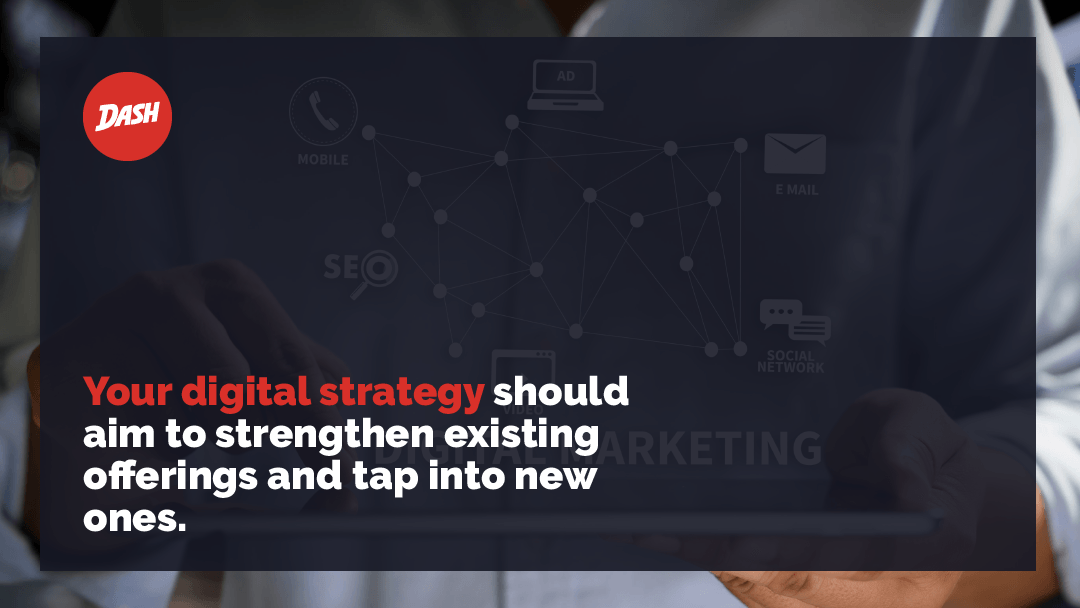
Rule 3: Manage Priorities
When choosing which areas to focus on, a customer-centric approach based on competitive advantage and value creation is critical. To figure out where to place your priorities, ask yourself: of all the customer pain points that a digital strategy can address, which ones are your professional services organisation positioned to meet? Which of those offerings have the greatest value potential to your organisation?
In general, focusing on two or three pain points to start often leads to greater clarity of what can be accomplished. Short-term wins like digital marketing can help your organisation achieve specific digital goals while winning new business and increasing your bottom line.
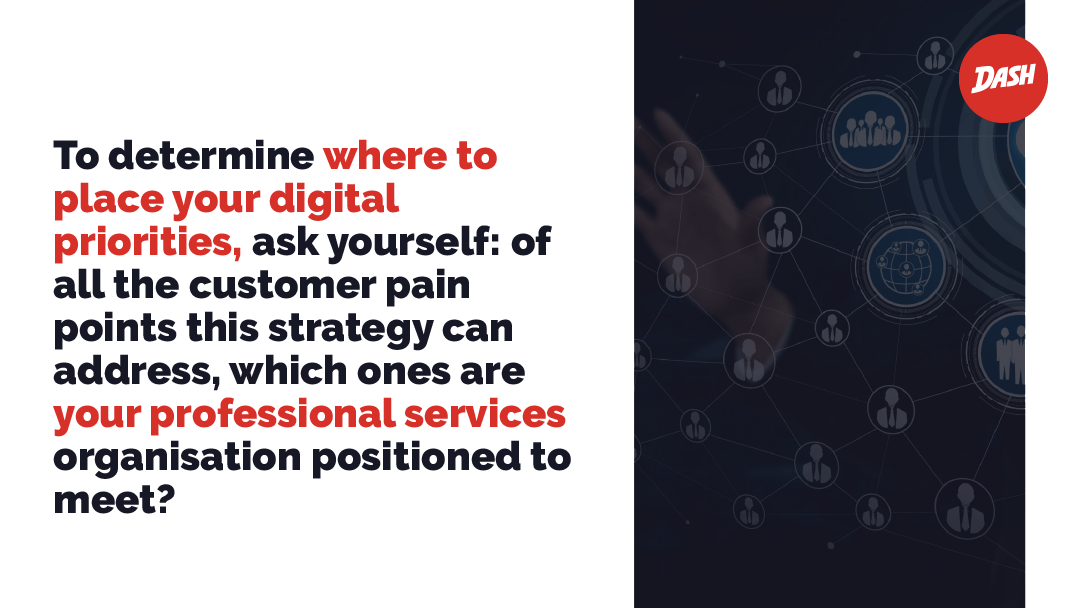
Rule 4: Increase Digital Capabilities
Building a digital strategy calls for an open mind and cultural shifts. Professional services organisations must build new “strategic muscles” that strengthen their traditional offerings and ensure old and new processes work together in a coordinated way. Adopting a digital culture is essential to a successful digital strategy. Leadership and staff must work as one to meet the challenges a digital transformation brings.
Rule 5: Actively Manage Digital Strategies
While you don’t need to transform your entire operation when building a digital strategy, some issues should be considered, such as industry and market trends. As with any organisational changes, a digital strategy must be tracked for success and processes adjusted as needed.

Where A Digital Strategy Fits in Your Business Strategy
From a marketing point of view, a digital strategy is simply a plan:
- What is our goal?
- What do we want to improve in our marketing function?
Once there’s a defined goal, we focus on what we here at Dash refer to as “The 3Bs.”
- B is for Buyer. Who is the buyer? What are their needs? What is their buyer’s journey, and how do they go through making a purchasing decision?
- B is for Brand. What is your brand or message? How will we align your business and your solutions to your buyer at every stage of their journey?
- B is for Build. This is where digital transformation comes into play in the marketing function. What core infrastructure needs to be in place to allow you to consistently showcase and deliver your brand and its message to your buyers at the right stages over the course of their journeys?

Your organisation’s core infrastructure can include things like:
- A website.
- Lead generation, capture, and nurturing methods.
- How subscriber, customer, member, and lead data is automatically collected, stored, and maintained.
- How content is distributed to buyers.
- How digital processes are integrated with necessary manual ones, such as the sales process. For instance, can your digital infrastructure notify someone in sales or in business development when a lead should be manually called?
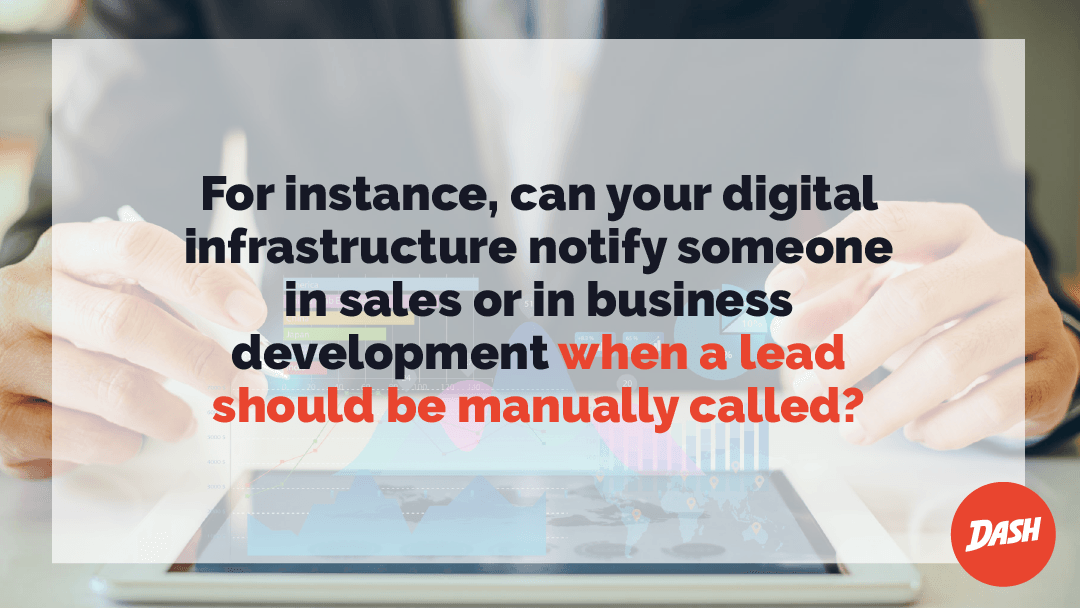
Do some digital strategies work better than others? For certain organisations, yes. But what all successful professional services digital strategies have in common is they focus more on new customers and new services and less on cost-efficiency.
Many professional services organisations find that one of the most effective digital tools is their website. Yet most firms miss out on the major opportunities a website offers, using it instead as an expanded Yellow Pages.
Eighty-five percent of consumers say they conduct online research before making a purchase. For professional service organisations, that number is greater than 60 percent. In a digital world where customers are in control, your organisation’s website can be an incredibly powerful tool for driving new business relationships and connecting with more clients.
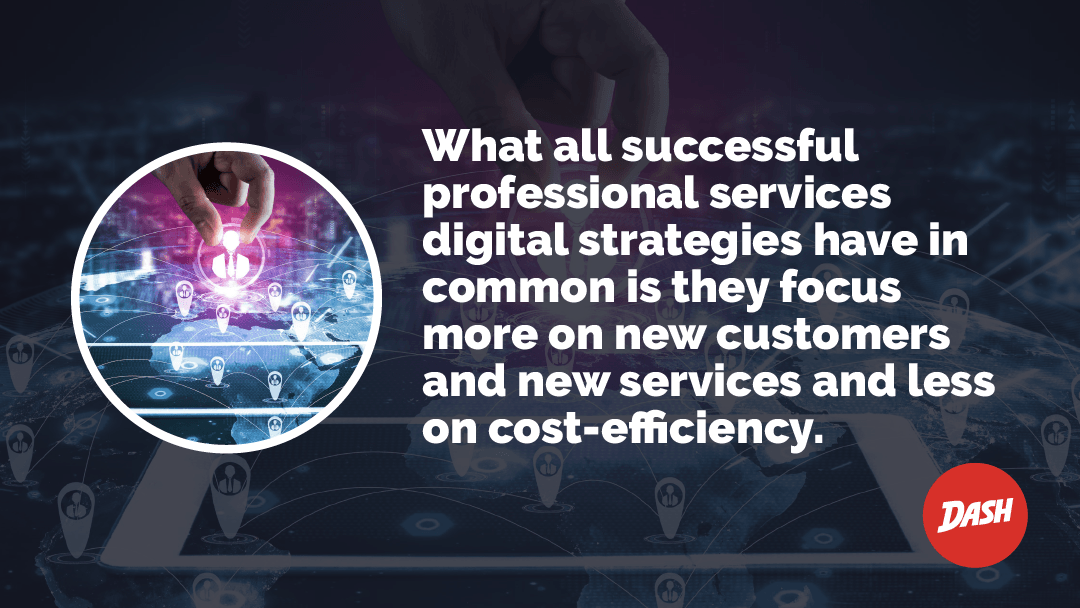
When Digital Strategies Fail
When a digital strategy fails, it’s generally because there was a failure to plan. To return to our website discussion:
- Has your site been designed to capture new clients or just feed people information?
- Does your website look like your competitors’ sites? Was it built with a generic template?
- Can visitors to your site immediately tell what sets your organization apart?
- Is your site set up to close deals?

So, again, it’s important you:
- Have a clear goal, a singular vision for what you want your digital strategy to achieve.
- Define what a successful digital strategy looks like.
- Build a consistent brand.
- Decide which channels to invest in.
- Invest sufficient time and money to make the strategy work.
- Be willing to take the competition head-on with a competitive positioning strategy.
- Track and measure your efforts.
A digital strategy that lacks stringent planning is like throwing darts blindfolded. You can’t see where you’re aiming, and you can’t see if your darts are hitting their mark. Developing a solid digital marketing plan helps you identify what makes your professional services organisation unique and makes sure your message is delivered to the right audience at the right time on the right channels.
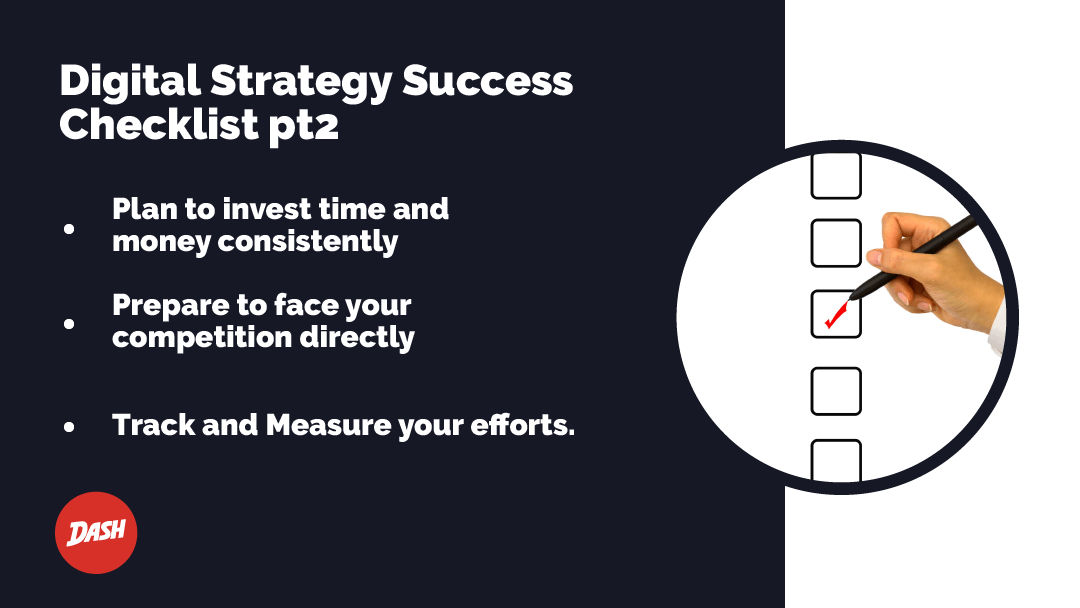
Assessing Digital’s Strategic Impact
When it’s time to evaluate your organisation’s digital strategy, we can circle back around to where we began: with the 3Bs.
- Buyer. Are you reaching your ideal client, or is it time to reexamine your target customer profiles? Have you clearly articulated how your solutions can solve their pain points? Are your messaging strategies working? Are key words and phrases hitting their mark?
- Brand. Are you digitally present in the right places? Are you marketing your brand where your audience hangs out? Is it time to reevaluate how you’re positioning your brand?
- Build. Is your message reaching potential leads at the right stage of their journey? What is your overall ROI?
If you want to see a return on your digital transformation and digital strategy goals, they should align with your business priorities. Put another way, your digital efforts should always aim to advance significant organisational goals and solve problems for your customers. Defining your brand’s vision, goals, and priorities is a great foundation for your digital strategy.
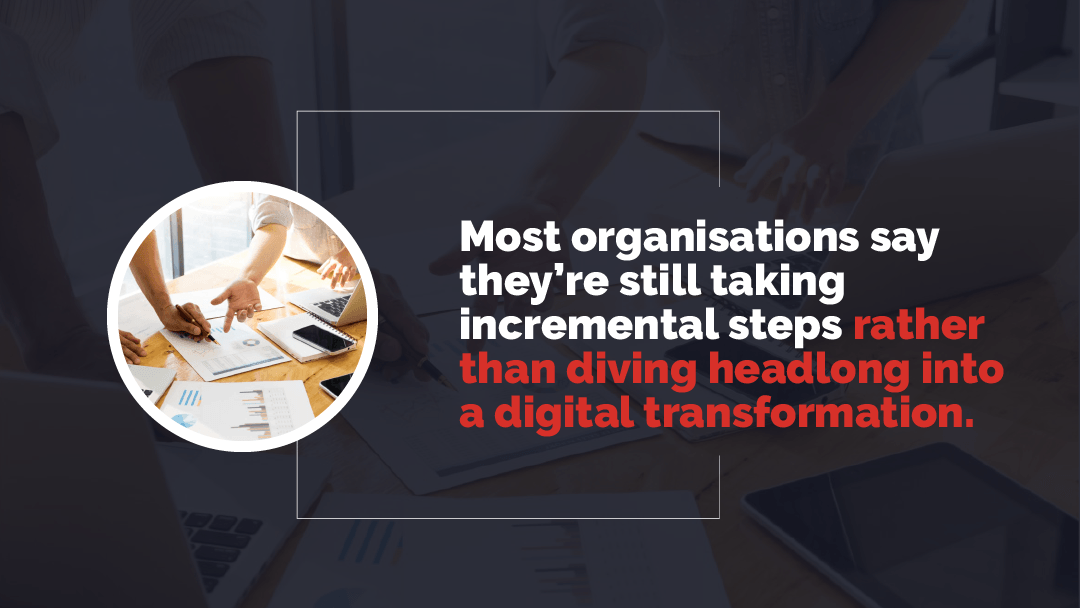
Is Your Professional Services Organisation Ready For a Digital Overhaul?
Most organisations say they’re still taking incremental steps rather than diving headlong into a digital transformation. That’s not necessarily a bad thing. Steadily fixing outdated or broken processes can still have an enormous impact on your bottom line. As long as you begin to develop a plan to get from where you are to where you want to be in terms of digital marketing, you’ll be better positioned to reach your growth goals.



